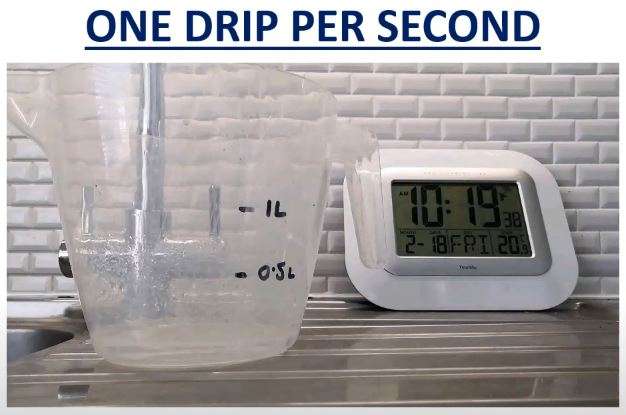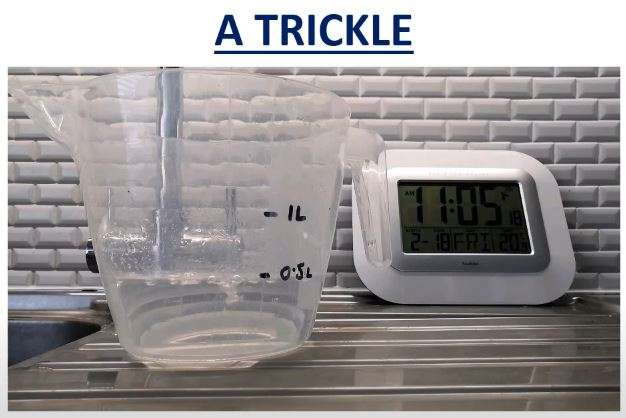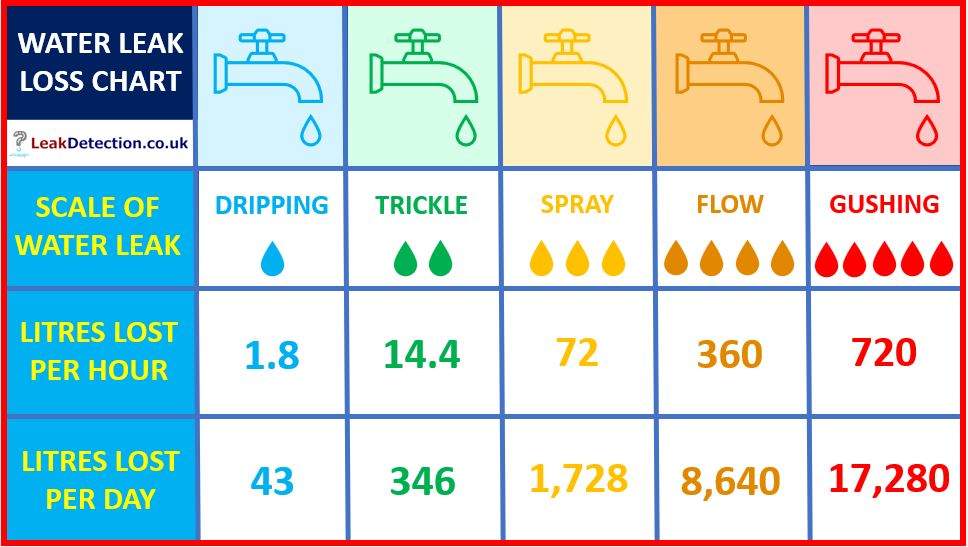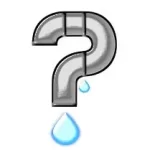One of the most common questions people have is – How much water is my leak using? This is an understandable question for two reasons. Firstly, to understand how much water is leaking into your property and, secondly, what the potential cost might be (if you are on a water meter).
Even if you are not on a water meter, nobody likes to waste water. So we set out to demonstrate how much water is lost in a water leak. We even made a YouTube video out of it to help visualise it for you.
How do you Measure a Water Leak?
In our test in the video above, we used:
- A dripping tap to simulate a water leak – at two ‘speeds’ a drip and a trickle
- A measuring jug to collect and measure the water (we collected 500ml / 0.5 litres)
- A clock to measure the time taken to get to that level
- A time lapse camera to record it, sped up to make it quicker
A dripping tap is a good way of simulating a plumbing leak, the sort of thing that we find regularly as part of our leak detection services around the York and Yorkshire Coast Area. Plumbing leaks are the most common type of leak that we deal with, but that does not make them easy to find, especially for those who are not experienced leak finders, which is where our leak detection expert team come into action with their specialist knowledge, training and leak detection equipment, including leak detectors.

Water Leak Test 1 – a Dripping Leak
This is the left-hand part of the video we showed earlier. For the test, we opened the tap slightly so that it was roughly dripping once per second. An example of this might be a dripping tundish on your boiler. At that speed, it does not look like you are wasting much water from your water leak but is that so? Let’s look at the numbers from the test:
- It took 25 minutes to get to the 500ml (half a litre) level on the jug
- That means that in an hour the drip leak uses 1.2 litres per hour
- Multiplying this by 24 hours in a day, that leak would use 28.8 litres a day
- That is 201.6 litres per week or 10,512 litres per year – all from a drip!
As you might expect, that amount of water (from what seems like a small water leak) is actually quite a lot over time. If that was behind a wall, or in a floor or ceiling leak, the damage could be significant.

Water Leak Test 2 – a ‘Trickle’ Leak
The second test we did, as shown on the right-hand side of the video, was a ‘trickle’ leak simulation. This time, as you’d expect, we set the tap to a fairly slow trickle. As you might expect, how much water is used was more than a drip, but how much water more? Lets take a look:
- It took just 5 minutes to get to the 500ml (half a litre) level on the jug
- That is 5 times faster than for the dripping tap leak
- That means that in an hour the drip leak uses 6 litres per hour
- Multiplying this by 24 hours in a day, that leak would use 144 litres a day
- That is 1,008 litres per week or 52,560 litres per year
- That is a staggering amount of water, all from a trickle!
If you have a water leak at your property, contact us.
Now you can understand why we always say!…

Water Leak Loss Chart
Below is a useful water leak loss chart so show an estimate of how much water different scales of water leak could lose based on different types of leak, as you can see again it adds up:

As you can see, the drip and trickle are slightly higher than our test but this can be explained by the fact that they are assumed on slightly faster drips (more per second) and faster trickles and therefore how much water is lost is higher. Again, these are indicative to give a rough idea of the scale of water loss.
How Do I Know I Have a Water Leak?
Here are the main possible signs of a water leak at your property:
- You can see water damage at your property (damp on walls, ceilings or floors)
- Linked to that, problems with condensation, damp and mould
- This can include mould on walls
- Your central heating boiler pressure keeps dropping
- You have a higher than normal water bill, on that…
- In fact, you may get told you have a Yorkshire Water Leak from them
- Linked to that, a drop in water pressure can signify a leak
- You can see structural damage – cracks or soft spots for example
Clearly, if you are seeing more than one of these things above, then the higher the potential you have for a water leak at your home or business. Be on the lookout and get help if needed.
We are experts in finding water leaks for people in the York and Yorkshire Coast area, so if you have a water leak, or think you might have (from seeing things on the list above), please contact our friendly team to arrange for one of our leak detection engineers to come and help you find your leak, including leaks under houses.
Top Tip
Leak Detection Team
“There are common signs of a water leak, so be aware of them and, if you spot things that might indicate a water leak at your home – get help from a water leak detection company to help you find the leak.”
How Much Water do Things in my House Use?
Clearly how much water things hold will depend on the size of them, but for a bit of an indication, and as a bit of fun, here is what some common household items hold or use:
- Although it holds more, most people use about 100 litres of water for a bath
- In comparison, a shower uses about 50 litres of water on average
- Flushing the toilet uses about 10 litres of water for a full flush
- A washing machine uses about 60 litres on a regular wash
- A dishwasher uses about 10-20 litres on a regular cycle
- An average kitchen sink holds about 20-30 litres
- A radiator holds about 5-10 litres of water
On the topic of how much water appliance leaks might involve, we have a great guide explaining the answer to why is my washing machine leaking? – it’s got some useful help and advice.
Hopefully you found this short article useful to see how much water a leak potentially loses from it. As we said earlier, it adds up very quickly, especially as many water leaks are running 24/7! We discuss this more in our article about kitchen sink leaks.
You might find our article on the signs of a boiler losing pressure useful to read too. As is our article on water meter reading, which can help with spotting leaks.
We offer a full trace and access service for insurance companies, property managers & landlords as well as for the general public. We help people to find water leaks of all sizes. So no matter how much water you are losing, big or small, we can help you find your water leak, using our specialist equipment.
At Rainbow Restoration – York & Yorkshire Coast we are experts in Leak Detection and Water Damage Restoration, so if you need help finding a water leak or getting your property back to normal after a leak or flood, get in touch with our friendly local team who will be happy to help you with this.

How much damage can a water leak cause?

The amount of damage caused by a water leak will depend on a number of factors, these include – the amount of water that has leaked, the type of water (tap water is different to sewer water!), how long the leak has been going, the location of the leak in the property (and what it is near) and the layout, age and design of the property it has affected. Accordingly, damage can be small or large.
How much water leak is normal?

In the vast majority of cases the normal amount of water you should leak is zero / nothing. If everything is operating as it should be with the plumbing and heating in your home or business you should not be losing water from a leak. If you do think you have a leak, however small, do not ignore it and get help asap. Otherwise, you risk the leak getting worse and damage being caused to your property.
Why is water loss a problem?

There are a number of reasons that water loss in a property can be a problem. Firstly, it can be costly, especially if you are on a water meter and are charged on how much water you use. Secondly, it can cause a lot of water damage to your property if you are not careful, especially over time. And finally, put simply it is wasteful as not only is water a precious resource but it costs energy to produce.